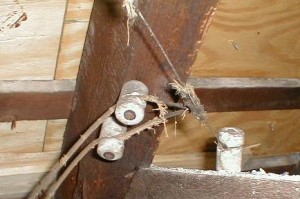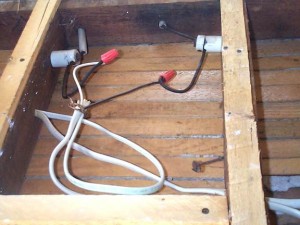Is Outdated Knob-and-Tube Wiring Making Your Home a Fire Risk?
Is Outdated Knob-and-Tube Wiring Making Your Home a Fire Risk?
 Historic homes have a certain charm and appeal for buyers that just cannot be matched in more modern designs. Older homes may offer crown molding, solid wood floors, and even leaded glass for the windows, and they may also have a history and a story behind them. Many homebuyers are willing to put up with a few creaks in the flooring or dampness in the basement for the sake of owning an older home, and some are also more than happy to invest in upgrading an older home’s features for the sake of livability and safety.
Historic homes have a certain charm and appeal for buyers that just cannot be matched in more modern designs. Older homes may offer crown molding, solid wood floors, and even leaded glass for the windows, and they may also have a history and a story behind them. Many homebuyers are willing to put up with a few creaks in the flooring or dampness in the basement for the sake of owning an older home, and some are also more than happy to invest in upgrading an older home’s features for the sake of livability and safety.
If you’re considering purchasing an older home or live in a home built before the 1940s, it’s good to understand all the features that may need updating for convenience and for your family’s safety. One important consideration is the wiring and electrical systems. Starting in the late 1800s and continuing until the 1940s, a home’s electrical system was typically constructed with what is called knob-and-tube wiring, and while it was standard for the time, this type of system can pose a significant fire risk today.
Understanding Knob-and-Tube Wiring
What exactly is meant by knob-and-tube wiring? This is a system that used actual porcelain knobs to attach and anchor the electrical wiring to the studs in the wall and to the joists in the floor. Insulated tubes were also used to thread the wires through areas of the walls and any other obstructions.
This type of knob-and-tube wiring is easy for most electricians to see because it would use separate neutral and hot wires that were actually suspended to help keep them cool, and the wires ran parallel to each other. There is no ground wire with the knob-and-tube wiring system, and this is one of the dangers for today’s appliances that use a three-prong outlet. Without this additional ground wire, there is an immediate chance of electrical fire.
 Modifications Over the Years
Modifications Over the Years
Another challenge with knob-and-tube wiring systems is that they’re often modified through the years rather than being replaced. During the time when this system was popular, homes did not require much electricity as they were not supporting appliances like central air conditioners, dishwashers, heavy-duty refrigerators and freezers, and modern-day entertainment centers. A century ago when they were popular, homes needed just enough power to run electric lights and perhaps the occasional fan.
Rather than changing out these systems, many electricians would instead simply try to retrofit them or modify them to support the demand for electricity in modern homes. Running them through junction boxes just compromises the wiring all the more and increases the risk of fire. Some have even suggested that home inspectors disclose knob-and-tube wiring in their inspection reports so homeowners understand the wiring they have and can understand the challenges they may face.
Insulation an Added Risk
Adding insulation over knob-and-tube wiring is another reason that this type of system is such a fire risk. When a person buys an older home they often immediately add insulation to areas of the attic and walls, as this is often missing in these homes. However, they may unknowingly and unwittingly add this insulation right over the knob-and-tube wiring! This can easily cause the wiring to become too hot and catch fire as the entire system is meant to stay exposed to air to keep it cool. The National Electric Code actually prohibits this system from being used in areas that are insulated by blown foam, rolled, or loose insulation, including walls, ceilings and attics.
What to Do as a Homeowner
As with any electrical repair, a homeowner should never try to remove or replace knob-and-tube wiring on their own, but should always call an experienced, licensed electrician. Because of the challenges of working with knob-and-tube wiring, most electricians will recommend having it replaced altogether rather than trying to update it or make it work with today’s appliances. There are no codes that require it to be removed from a home completely, but some local codes actually demand its removal from accessible areas, so do not be surprised if this is the recommendation from your electrician.
Many homeowners hesitate at the thought of removing and replacing their home’s entire wiring system, but this is something that can typically be done in stages and may be easier to accomplish during remodeling when the home’s wiring is already exposed. As a homeowner you may opt to start with areas that use the most power such as the kitchen, or areas where you want to add insulation or ensure safety such as the attic. Some electricians can also run dedicated lines for certain appliances in other areas that still use knob-and-tube wiring.
Remember that your family’s safety and the safety of your home should be of prime concern, so consider an investment in replacing your knob-and-tube wiring. This will allow you to enjoy your older home in comfort!
To Read More Where Our Owner, Bill Hyman, Is Interviewed Click Here!



